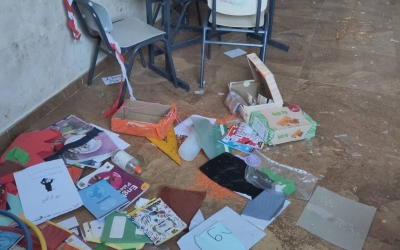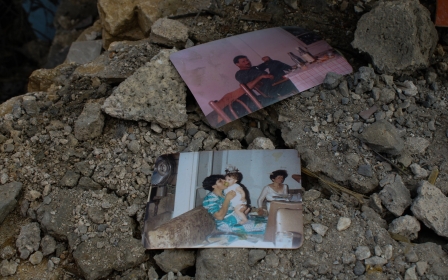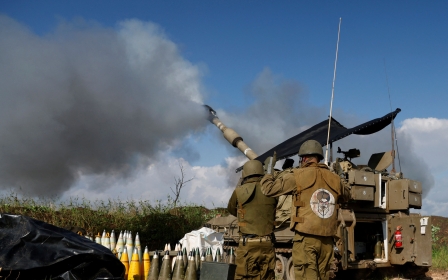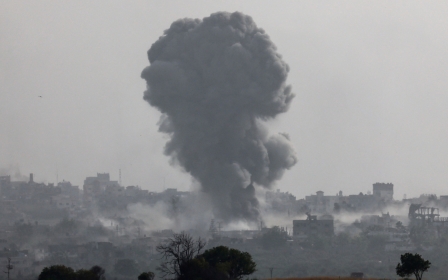Lebanon war exposes lack of shelter for Palestinian citizens of Israel

On 5 October, in the Palestinian village of Deir al-Asad in northern Israel, rockets fired from Lebanon by Hezbollah brought devastation and death.
At the Western Galilee Hospital in Nahariya, Israel's northernmost coastal city, doctors said they had received 49 casualties.
As the war between Israel and the Lebanese movement shows no sign of stopping - and as Iran and Israel periodically exchange missile fire - the huge gap between Palestinian citizens of Israel and Jewish Israelis is reflected in the lack of shelter and safe places inside Palestinian towns, compared to Jewish Israeli ones.
Murad Ammash is the head of the local village council in Jisr al-Zarqa, a Palestinian town on Israel's northern Mediterranean coastal plain.
"In general, since the establishment of the state of Israel, there has been negligence in all areas of life - planning and construction, the economy and infrastructure, as if the Arab towns were out of the picture," he told Middle East Eye.
New MEE newsletter: Jerusalem Dispatch
Sign up to get the latest insights and analysis on Israel-Palestine, alongside Turkey Unpacked and other MEE newsletters
"Perhaps only 10 years ago they started talking about Arab society. In Jisr al-Zarqa, today, 16,000 citizens live in the town in an area of 1,400 dunams (345 acres). The area includes streets, schools, facilities, institutions, and places for housing. In contrast, around 900 citizens live in neighbouring Beit Hanania on an estimated 3,000 dunams (740 acres)."
Ammash said that in 2006, Jisr al-Zarqa residents began to request to expand the area. "Building the structural map took 11 years with the planning ministry, due to strong opposition," he said.
"More than 64 Jewish neighbours submitted objections - in contrast, building a structural map for a Jewish town takes only two years. I see no hope for our village to expand because Israel built Highway 2, linking Haifa and Tel Aviv, which has limited the village’s development from the eastern side," Ammash said.
Talking about the situation in the current war, he said: "We face many dangers. The village is surrounded by strategic places, one of which is the gas station, and in the southern side there is an important power station."
What constitutes shelter?
"When talking about providing shelters or safe places, we are specifically talking about three types of places," lawyer Ameer Bisharat, CEO of The National Committee for Heads of Arab Local Authorities in Israel, an organisation that represents Palestinian citizens of Israel, told MEE.
"The first is a shelter inside the home, the second is a shelter inside an institution affiliated with the local authority - such as schools or community centres – and the third is what is known as a mobile bomb shelter. Within each of the three types, there are vast gaps between Arab and Jewish towns."
'[Israel's land policy] discriminates against Palestinian citizens of Israel and in favour of Jewish citizens'
- Human Rights Watch
Historically, Israel has not imposed any legal obligation on its citizens to build a shelter inside private homes, not to mention that the homes of most Palestinian citizens of Israel existed before the Nakba and the creation of Israel.
"In fact, we were all here before Israel," Bisharat said of Palestinian citizens of Israel, who make up almost 21 percent of the country's population.
In 1991, at the end of the Gulf War and following Iraq's scud missile campaign against Israel, which focused on Tel Aviv and Haifa, civil defence regulations were updated, with every new apartment built required to be attached to a residential protected area.
Decades of discrimination in land and housing policies have left most Palestinian citizens of Israel living in densely populated cities and villages, leading to what Israel sees as illegal construction. This means building work that does not meet the required standards and does not include shelters. This can result in the demolition of homes, rather than in policy change.
According to the Arab Center for Alternative Planning, a non-profit organisation based in the Galilee, around 30,000 buildings are at risk of demolition and are inhabited by about 130,000 Palestinian citizens of Israel.
According to Adalah, the Palestinian-run legal centre in Israel, the land and housing crisis is not a result of specific failures or unintentional neglect. It is "the product of a systematic and deliberate policy carried out by the state since 1948 that has viewed Palestinian citizens of Israel as enemies and aliens, while the state pursues its agenda to 'Judaize' all parts of the country."
In another report, Human Rights Watch asserted that Israel's land policy "discriminates against Palestinian citizens of Israel and in favour of Jewish citizens, sharply restricting Palestinians' access to land for housing to accommodate natural population growth."
In 2017, the Knesset, Israel's parliament, approved the "Kaminitz law", which, according to Adalah and other human rights organisations, was designed to increase the "enforcement and penalisation of planning and building offences".
The law does not take into account decades of systematic discrimination in state land planning and allocation, which has resulted in a severe housing crisis in Palestinian towns and villages throughout Israel.
Since Israel was created, the state has not built a single town for its Palestinian citizens.
Emergency disparity
According to a survey of 33 Arab towns in the Galilee, central Israel and the Negev (Naqab) carried out by The Injaz Centre for Professional Arab Local Governance (Injaz), areas in which Palestinian citizens of Israel live are not equipped to deal with emergency situations.
"Some Arab communities lack any public shelters, while in others, the only public shelters are within educational institutions like schools and kindergartens," the Injaz report reads.
"Additionally, in some communities, there are no shelters within educational institutions, and in some cases, rooms designated as shelters have been converted into classrooms or laboratories due to a significant shortage of classrooms in Arab society."
There is also a huge disparity in the availability of mobile shelters between Jewish and Palestinian areas in Israel.
In northern towns, where residents have 30 seconds or less to reach a protected area after a missile siren sounds, the division is stark.
In Karmiel, a Jewish city with a population of about 55,000, there are 126 shelters. In Deir al-Asad, where about 14,000 Palestinian citizens of Israel live, there is only one shelter and in Nahef, a village a little larger than Deir al-Asad, there are no shelters at all.
'Two years ago, we were able to obtain two mobile shelters from the housing ministry, which was an almost impossible task'
- Murad Ammash, village council head, Jisr al-Zarqa
Nahed Khazem, mayor of the city of Shefa-Amr in Israel's northern district, told MEE that by the beginning of the war, they had requested 18 mobile shelters.
"This was after a tour we conducted with the home front command engineer, but they only sent us three shelters. The historic city of Shefa-Amr is made up of old buildings. We need at least 18 shelters. They said this is a first batch and that in the future we will be provided with additional shelters, but we do not need them after the war," Khazem said.
"The psychological factor of the presence of these mobile shelters has a major impact on psychological immunity - but we will continue to put pressure on them until the other shelters are provided."
Sometimes, when shelters are provided, there is no room to accommodate them.
Ammash told MEE Jisr al-Zarqa needs at least 10 shelters - and at least 60 percent of its homes are without shelters because they are old houses (the village was founded in 1800).
"Even if we wanted to bring a mobile shelter, there is not a single centimetre of space to place them," he said.
"Two years ago, we were able to obtain two mobile shelters from the housing ministry, which was an almost impossible task. We placed one in a shared courtyard for three schools, which affected the students' well-being, and the second in a sports hall courtyard, at the expense of a space that could be a space for bicycles. We give up services in exchange for other services."
Bedouin Palestinians exposed in the south
In the Negev (Naqab) desert, the situation is starker.
Today, more than 300,000 Palestinian Bedouin citizens of Israel live in the Negev, of which about 80,000 live in about 35 unrecognised villages, according to Adalah.
In these villages, not only are there no shelters, but Israeli air defences define the land as an "open area" because their existence is not acknowledged. For the Israeli military, this airspace is an ideal place to intercept missiles.
On the day of the Hamas-led 7 October attack, six children were killed in the Negev by shells falling on their villages, with no sirens sounding. In these towns, people live in buildings made of tin panels. There are no concrete buildings. Children run outside during the bombing and hide behind piles of sand.
Huda Abu Obaid, a Palestinian human rights defender from the Negev Coexistence Forum for Civil Equality, told MEE that efforts are being made to provide protection, thanks to some civil society organisations, but that it is far from being enough.
According to the forum, there are a number of major issues preventing the residents of unknown villages from protecting themselves and their families.
The first is the cost of construction, with residents among the poorest people in all of Israel and unable to afford the estimated cost of a home shelter, which is $37,000.
The second is the lack of a permit. The Israeli state does not recognise the existence of the villages, therefore they do not have approved outline plans and residents cannot build shelters, even if they have the money.
During the 2006 Lebanon war, 18 of the 43 Israeli citizens killed were Palestinian. Today, with the death toll expected to be far higher, the situation looks just the same.
Middle East Eye delivers independent and unrivalled coverage and analysis of the Middle East, North Africa and beyond. To learn more about republishing this content and the associated fees, please fill out this form. More about MEE can be found here.






